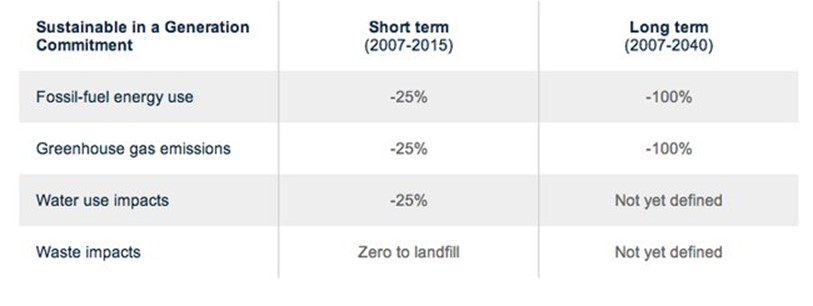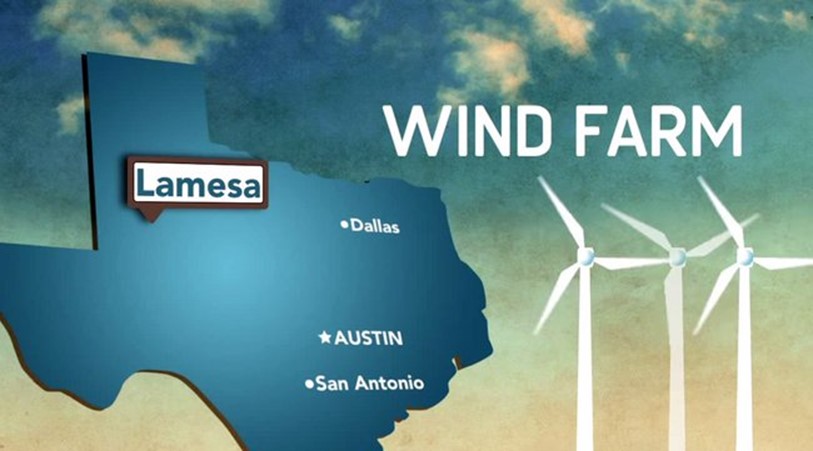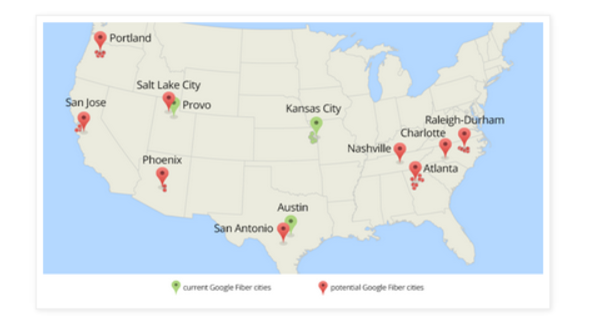With dozens of cities proposed for gigabit fiber, Google, AT&T and others are expected to rush to tack on Wi-Fi to offer ads and services.
A mega-battle is brewing between corporate giants such as AT&T, Google and Time Warner Cable to build Wi-Fi hotspots in U.S. cities connected to massive gigabit fiber-optic or fast networks of cable providers.
In the coming years. Google — and likely its competitors– are likely to pump free or low-cost Internet service to city centers and shopping areas, granting shoppers and other users access to a wide array of the services and advertising that are central to Google’s revenue model.
Both AT&T and Google recently announced proposals to provide gigabit fiber services to dozens of U.S. cities — and Wi-Fi connected to the fast fiber is expected to be a part of that offering.
Over the past several years, Time Warner has been busy provisioning its modern cable network to add 11,000 Wi-Fi hotspots for its Internet customers to use for mobile devices in various Kansas City area locales, including stores, parks, walking paths and nightlife spots like the popular downtown eight-block Power & Light District. During the last two years the Google Fiber network has steadily mushroomed to 6,000 fiber-optic miles throughout the KC metro area, but it hasn’t been connected so far to Wi-Fi.
In a 10-page document obtained by the IDG News Service, Google informed 34 cities that are candidates for Google Fiber in 2015 that it will be “discussing our Wi-Fi plans and related requirements with you as we move forward with your city during this planning process.”
Google, in part, appears to be responding to AT&T’s several year history of supporting up to 34,000 Wi-Fi hotspots nationwide. For instance, AT&T runs a Times Square “hotzone” in New York city as well as hotspots in other city centers and restaurants that can be used without charge by select AT&T home Internet customers who are going mobile with smartphones and tablets.
Prospects that AT&T will expand its Gigapower 1 Gbps fiber optic offering to include Wi-Fi in 21 cities is about potentially adding new services, paid for by end-users or third parties. And for Google, the potential for Wi-Fi atop of Google Fiber “is all about market creation for new kinds of ads and services,” said Patrick Moorhead, an analyst at Moor Insights & Strategy.
“The fatter the pipe — whether via fiber or Wi-Fi connected with fiber — more of the user experience can be delivered a remote datacenter, which is a strategic advantage for Google,” Moorhead added. “Google could put ads on everything from billboards to smart mirrors to the sides of buildings much, much easier.”
“Also, pervasive, fast connectivity means you can have more dumb clients that get all their horsepower from the cloud as a service,” he added
Jack Gold, an analyst at J. Gold Associates, said even AT&T’s reliance on Wi-Fi in many locations hasn’t been sufficient to handle the coming bandwidth load of uses, especially things like video over Netflix, YouTube and video used in ads.
“As users increase their use of rich media, they load up the networks pretty badly, and with an expected 1000x bandwidth increase needed by 2020, there’s a real problem,” Gold said.
“Google is seeing the writing on the wall as well as AT&T and wants to make sure it can offer its enhanced services where bandwidth may be constrained,” Gold added. “If you have a slow network, serving ads and serving up YouTube is a terrible experience. And with a terrible experience, users won’t go there. And if they won’t go there, Google can’t serve you ads … and generate revenues per click. For Google, it’s all about making sure they can maintain the click rates they need to keep their money machine going.”
In cities where Google Fiber is already being rolled out, city and neighborhood leaders have reported that Google has refused in the past to connect its fiber to Wi-Fi for use in apartment buildings and low-income housing projects. They say Google contends that such Wi-Fi service wouldn’t be secure or reliable, especially with the signal passing through concrete walls.
Google now holds a more positive stance on public locations for its Wi-Fi, especially outdoors, where concrete walls aren’t an impediment.
“We would be interested in providing public, outdoor Wi-Fi access to our Google Fiber cities, although we don’t have any specific plans to announce right now,” Google spokeswoman Jenna Wandres said Friday.
She refused to say if Google’s “public” approach would allow anyone with a Wi-Fi ready device to join the Google Wi-Fi or only Google Fiber customers, in keeping with the approach of some other providers.
The Google Wi-Fi locations will probably be similar to what Google has done in Mountain View, Calif., according to a community activist who asked not to be identified. “Knowing Google’s past behavior, its locations for future Wi-Fi will be based on where they can get the most useful consumer information to resell to advertisers and push their products,” the activist said. “Don’t forget, mining individual user data is how Google has made their billions.”
Time Warner appears to be following a similar strategy in the Kansas City area, where residents have noticed Wi-Fi hotspots pop up to add convenience to smartphone-or tablet-carrying Time Warner customers.
Activists speculated that the cable provider is sapping up the free, unlicensed Wi-Fi spectrum in its many Kansas City locations, which essentially stalls competing providers from moving in. Instead of a land grab, there’s a kind of spectrum grab. Time Warner wouldn’t comment on that speculation.
AT&T remains noncommittal about predictions it will add Wi-Fi to its Gigapower fiber networks in 21 candidate cities. When AT&T meets leaders in those cities, “we are willing to explore ways in which AT&T can help meet [city] needs,” spokeswoman Kurko Wong said via email.
Noting AT&T’s history of making Wi-Fi available at 34,000 hotspots in 50 states for free to some of its customers, she added, “we’re committed to making the benefits of Wi-Fi widely available.”
Customer response to the AT&T Wi-Fi “has been better than expected,” she added, as smartphones, laptops and tablets have proliferated. Over a few months in 2010, AT&T found that its customers made more than 350,000 connections to Wi-Fi hotzones in New York City, Charlotte and Chicago.
As AT&T and others have found, Wi-Fi hotspots are clearly hotter than ever, and major companies are positioning themselves to cash in.
Via: itworld


